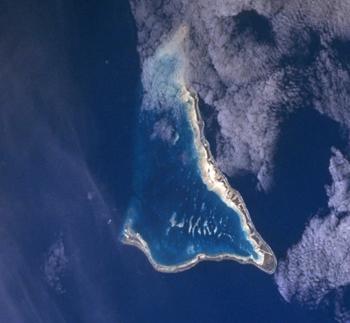Tiny Pacific Island nation slipping beneath the ocean waves
The island of Tarawa, home to about half of the Kirbati people.
Story by Living on Earth. Listen to audio above for full interview.
Kiribati is a collection of 32 atolls and a coral island, home to 100,000 people spread over more than a million square miles of the Pacific Ocean.
The low-lying land is covered with palm trees and surrounded by pristine reefs that will all soon disappear.
Global warming is melting the ice caps, raising the level of the seas and ultimately sinking Kiribati under the waves, forcing the Kirbati people, who’ve lived on the islands for 3,000 years, to find a new home.
President Anote Tong said one option under consideration is actually building massive platforms, like oil drilling rigs, on which the Kirbati people could live.
“Can you give me any other choices if our islands are going to be underwater?,” Tong said. “I mean, the only other option is to relocate, and that’s not very attractive I think. It would be so unfortunate if one day there would be no nation of Kiribati.”
Tong says any even marginal increase in sea level is devastating to his homeland. Saltwater has infitrated the fresh water ponds that allow the Kirbati people to cultivate crops. Another option being considered is creating actual islands, higher then the current ones. But it has a very costly downside.
“We understand it’s going to be an extremely, extremely expensive exercise. As you well understand, our islands don’t have a shelf — a continental shelf — so there is no material that we can dredge up,” Tong said.
Without a continental shelf, fill material would have to be imported from far-away continental land-masses, and then shipped to Kirbati.
Beyond preserving a physical homeland for the Kirbati people, there’s a real question about how you preserve their unique cultural identity.
“I think we would be able to better maintain our culture if the population could remain intact, in some form, in somewhere, with a distinct culture, some semblance of sovereignty,” Tong said.
So far, estimates for saving the nation of Kirbati stretch into the billions of dollars, and no real work has even been done yet. Sea walls are being built, but some of them are being overwhelmed as quickly as they’re put up.
Tong said no idea is too outlandish and he hopes to hear from engineers and scientists the world over with ideas for how Kirbati can survive as sea levels continue to rise.
————————————————————
Hosted by Steve Curwood, “Living on Earth” is an award-winning environmental news program that delves into the leading issues affecting the world we inhabit. More about “Living on Earth.”
